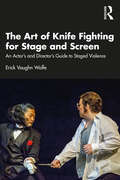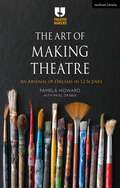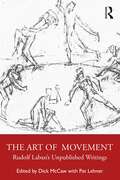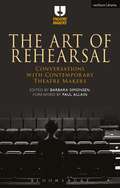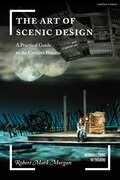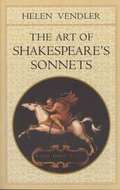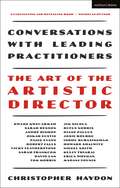- Table View
- List View
The Art of John Webster (Routledge Revivals)
by Ralph BerryThe Art of John Webster, first published in 1972, is a study of the three extant plays of Webster known to be solely his work. These plays are seen as attempts to achieve in literature the effects of the baroque, a term which related Webster to the larger developments of European art. Their content is analysed in terms of a consistent opposition between evil and the law. The book seeks to re-establish a base for the claims that must be made for Webster as a serious artist. This title will be of interest to students of literature and drama.
The Art of John Webster (Routledge Revivals)
by Ralph BerryThe Art of John Webster, first published in 1972, is a study of the three extant plays of Webster known to be solely his work. These plays are seen as attempts to achieve in literature the effects of the baroque, a term which related Webster to the larger developments of European art. Their content is analysed in terms of a consistent opposition between evil and the law. The book seeks to re-establish a base for the claims that must be made for Webster as a serious artist. This title will be of interest to students of literature and drama.
The Art of Knife Fighting for Stage and Screen: An Actor’s and Director’s Guide to Staged Violence
by Erick Vaughn WolfeThe Art of Knife Fighting for Stage and Screen: An Actor’s and Director’s Guide to Staged Violence provides detailed information for the safe use of knives and daggers in a theatrical setting and an in-depth understanding of safe theatrical weapons. The book starts with an extensive safety review, then moves on to the basic techniques of dagger fighting, starting with grip and body postures. Readers will then learn about the basic actions of cuts, parries, blocks, and disarms. During this process, they will explore the connection between body and weapon and start learning the elements of storytelling through choreography. Special attention is given to suicides, threats, and murder and how directors, choreographers, performers, teachers, and students can approach these techniques in a way that is physically and mentally safe. The book also covers the use of throwing knives, knife flips, and other tricks to help add a little flair to your fight. The Art of Knife Fighting for Stage and Screen teaches the safe theatrical use of the knife for directors, performers, educators, and students of stage combat.
The Art of Knife Fighting for Stage and Screen: An Actor’s and Director’s Guide to Staged Violence
by Erick Vaughn WolfeThe Art of Knife Fighting for Stage and Screen: An Actor’s and Director’s Guide to Staged Violence provides detailed information for the safe use of knives and daggers in a theatrical setting and an in-depth understanding of safe theatrical weapons. The book starts with an extensive safety review, then moves on to the basic techniques of dagger fighting, starting with grip and body postures. Readers will then learn about the basic actions of cuts, parries, blocks, and disarms. During this process, they will explore the connection between body and weapon and start learning the elements of storytelling through choreography. Special attention is given to suicides, threats, and murder and how directors, choreographers, performers, teachers, and students can approach these techniques in a way that is physically and mentally safe. The book also covers the use of throwing knives, knife flips, and other tricks to help add a little flair to your fight. The Art of Knife Fighting for Stage and Screen teaches the safe theatrical use of the knife for directors, performers, educators, and students of stage combat.
The Art of Law in Shakespeare
by Paul RaffieldThrough an examination of five plays by Shakespeare, Paul Raffield analyses the contiguous development of common law and poetic drama during the first decade of Jacobean rule. The broad premise of The Art of Law in Shakespeare is that the 'artificial reason' of law was a complex art form that shared the same rhetorical strategy as the plays of Shakespeare. Common law and Shakespearean drama of this period employed various aesthetic devices to capture the imagination and the emotional attachment of their respective audiences. Common law of the Jacobean era, as spoken in the law courts, learnt at the Inns of Court and recorded in the law reports, used imagery that would have been familiar to audiences of Shakespeare's plays. In its juridical form, English law was intrinsically dramatic, its adversarial mode of expression being founded on an agonistic model. Conversely, Shakespeare borrowed from the common law some of its most critical themes: justice, legitimacy, sovereignty, community, fairness, and (above all else) humanity. Each chapter investigates a particular aspect of the common law, seen through the lens of a specific play by Shakespeare. Topics include the unprecedented significance of rhetorical skills to the practice and learning of common law (Love's Labour's Lost); the early modern treason trial as exemplar of the theatre of law (Macbeth); the art of law as the legitimate distillation of the law of nature (The Winter's Tale); the efforts of common lawyers to create an image of nationhood from both classical and Judeo-Christian mythography (Cymbeline); and the theatrical device of the island as microcosm of the Jacobean state and the project of imperial expansion (The Tempest).
The Art of Law in Shakespeare
by Paul RaffieldThrough an examination of five plays by Shakespeare, Paul Raffield analyses the contiguous development of common law and poetic drama during the first decade of Jacobean rule. The broad premise of The Art of Law in Shakespeare is that the 'artificial reason' of law was a complex art form that shared the same rhetorical strategy as the plays of Shakespeare. Common law and Shakespearean drama of this period employed various aesthetic devices to capture the imagination and the emotional attachment of their respective audiences. Common law of the Jacobean era, as spoken in the law courts, learnt at the Inns of Court and recorded in the law reports, used imagery that would have been familiar to audiences of Shakespeare's plays. In its juridical form, English law was intrinsically dramatic, its adversarial mode of expression being founded on an agonistic model. Conversely, Shakespeare borrowed from the common law some of its most critical themes: justice, legitimacy, sovereignty, community, fairness, and (above all else) humanity. Each chapter investigates a particular aspect of the common law, seen through the lens of a specific play by Shakespeare. Topics include the unprecedented significance of rhetorical skills to the practice and learning of common law (Love's Labour's Lost); the early modern treason trial as exemplar of the theatre of law (Macbeth); the art of law as the legitimate distillation of the law of nature (The Winter's Tale); the efforts of common lawyers to create an image of nationhood from both classical and Judeo-Christian mythography (Cymbeline); and the theatrical device of the island as microcosm of the Jacobean state and the project of imperial expansion (The Tempest).
The Art of Looking: How to Read Modern and Contemporary Art
by Lance EsplundA veteran art critic helps us make sense of modern and contemporary artThe landscape of contemporary art has changed dramatically during the last hundred years: from Malevich's 1915 painting of a single black square and Duchamp's 1917 signed porcelain urinal to Jackson Pollock's midcentury "drip" paintings; Chris Burden's "Shoot" (1971), in which the artist was voluntarily shot in the arm with a rifle; Urs Fischer's "You" (2007), a giant hole dug in the floor of a New York gallery; and the conceptual and performance art of today's Ai Weiwei and Marina Abramovic. The shifts have left the art-viewing public (understandably) perplexed.In The Art of Looking, renowned art critic Lance Esplund demonstrates that works of modern and contemporary art are not as indecipherable as they might seem. With patience, insight, and wit, Esplund guides us through the last century of art and empowers us to approach and appreciate it with new eyes. Eager to democratize genres that can feel inaccessible, Esplund encourages viewers to trust their own taste, guts, and common sense. The Art of Looking will open the eyes of viewers who think that recent art is obtuse, nonsensical, and irrelevant, as well as the eyes of those who believe that the art of the past has nothing to say to our present.
The Art of Looking: How to Read Modern and Contemporary Art
by Lance EsplundA veteran art critic helps us make sense of modern and contemporary art The landscape of contemporary art has changed dramatically during the last hundred years: from Malevich's 1915 painting of a single black square and Duchamp's 1917 signed porcelain urinal to Jackson Pollock's midcentury "drip" paintings; Chris Burden's "Shoot" (1971), in which the artist was voluntarily shot in the arm with a rifle; Urs Fischer's "You" (2007), a giant hole dug in the floor of a New York gallery; and the conceptual and performance art of today's Ai Weiwei and Marina Abramovic. The shifts have left the art-viewing public (understandably) perplexed. In The Art of Looking, renowned art critic Lance Esplund demonstrates that works of modern and contemporary art are not as indecipherable as they might seem. With patience, insight, and wit, Esplund guides us through the last century of art and empowers us to approach and appreciate it with new eyes. Eager to democratize genres that can feel inaccessible, Esplund encourages viewers to trust their own taste, guts, and common sense. The Art of Looking will open the eyes of viewers who think that recent art is obtuse, nonsensical, and irrelevant, as well as the eyes of those who believe that the art of the past has nothing to say to our present.
The Art of Making Theatre: An Arsenal of Dreams in 12 Scenes (Theatre Makers)
by Pamela Howard Pavel DrábekIn this book, world-renowned theatre artist Pamela Howard OBE shows how her life has always been part of the art of making theatre. Part memoir, part a personal account of artistic creation, it is a work of art in its own right. Its 12 chapters, accompanied by original drawings, offer insights into Pamela Howard's creative world and the journey through life of a celebrated artist, ranging from her early life and influences, to her time at art college and the inspiration she gained from travelling the world. Following the trajectory of her life, the 12 'dreams' are poised between memory and history and give an account of an artist's growth, resilience, working patterns, and life-changing encounters with remarkable personalities and artists, as well as the practical side of working in the theatre, in visual arts and in education. Her art tells unexpected stories of little-noticed people and émigré communities, and makes performance for diverse audiences from the unique experience of one's own life. Pamela Howard's dreams have led her to work across the globe and teach and inspire several generations of theatre makers, scenographers, designers and visual artists. The Art of Making Theatre passes on that inspiration afresh and demonstrates that being an artist is not a one-off project but a way of life.
The Art of Making Theatre: An Arsenal of Dreams in 12 Scenes (Theatre Makers)
by Pamela Howard Pavel DrábekIn this book, world-renowned theatre artist Pamela Howard OBE shows how her life has always been part of the art of making theatre. Part memoir, part a personal account of artistic creation, it is a work of art in its own right. Its 12 chapters, accompanied by original drawings, offer insights into Pamela Howard's creative world and the journey through life of a celebrated artist, ranging from her early life and influences, to her time at art college and the inspiration she gained from travelling the world. Following the trajectory of her life, the 12 'dreams' are poised between memory and history and give an account of an artist's growth, resilience, working patterns, and life-changing encounters with remarkable personalities and artists, as well as the practical side of working in the theatre, in visual arts and in education. Her art tells unexpected stories of little-noticed people and émigré communities, and makes performance for diverse audiences from the unique experience of one's own life. Pamela Howard's dreams have led her to work across the globe and teach and inspire several generations of theatre makers, scenographers, designers and visual artists. The Art of Making Theatre passes on that inspiration afresh and demonstrates that being an artist is not a one-off project but a way of life.
The Art of Movement: Rudolf Laban’s Unpublished Writings
by Dick McCawThe Art of Movement: Rudolf Laban’s Unpublished Writings offers new perspectives on the thinking and practice of Rudolf Laban – one of the pioneers of modern European dance and movement analysis. A wealth of Laban’s previously untranslated writings broadens our understanding of his work through new perspectives on his thinking and practice. Alongside these key primary sources, interviews with Laban’s family and colleagues and editorial commentaries shed new light on the significance of his life and career. Laban’s own texts also offer further elaboration of the key themes of his work – eukinetics, choreutics, lay dance, pedagogy and dance notation. This essential companion to The Laban Sourcebook is an ideal resource for any students or scholars of modern dance, dance studies, dance history and movement analysis looking for a deeper understanding of this seminal figure in their field.
The Art of Movement: Rudolf Laban’s Unpublished Writings
The Art of Movement: Rudolf Laban’s Unpublished Writings offers new perspectives on the thinking and practice of Rudolf Laban – one of the pioneers of modern European dance and movement analysis. A wealth of Laban’s previously untranslated writings broadens our understanding of his work through new perspectives on his thinking and practice. Alongside these key primary sources, interviews with Laban’s family and colleagues and editorial commentaries shed new light on the significance of his life and career. Laban’s own texts also offer further elaboration of the key themes of his work – eukinetics, choreutics, lay dance, pedagogy and dance notation. This essential companion to The Laban Sourcebook is an ideal resource for any students or scholars of modern dance, dance studies, dance history and movement analysis looking for a deeper understanding of this seminal figure in their field.
The Art of Rehearsal: Conversations with Contemporary Theatre Makers (Theatre Makers)
by Barbara SimonsenWhat are the key elements that go into creating a work of art for the stage? Which are the most productive conditions and methods of rehearsal? In this collection of interviews, 18 international artists share their experience and offer practical advice on the creation of performance work. Their answers provide a goldmine of tried and tested approaches as they discuss the common problems and difficulties of creative work, their turning-point experiences, and ways in which they have challenged performers and themselves to go beyond conditioned reflexes to create groundbreaking new work.
The Art of Rehearsal: Conversations with Contemporary Theatre Makers (Theatre Makers)
by Barbara SimonsenWhat are the key elements that go into creating a work of art for the stage? Which are the most productive conditions and methods of rehearsal? In this collection of interviews, 18 international artists share their experience and offer practical advice on the creation of performance work. Their answers provide a goldmine of tried and tested approaches as they discuss the common problems and difficulties of creative work, their turning-point experiences, and ways in which they have challenged performers and themselves to go beyond conditioned reflexes to create groundbreaking new work.
The Art of Resonance (Theatre Makers)
by Anne BogartWhat is artistic resonance and how can it be linked to one's life and one's art? This latest book of essays from legendary theatre director Anne Bogart, considers the creation of resonance in the artistic endeavour, with a focus on the performing arts. The word 'resonance' comes from the Latin meaning to 're-sound' or 'sound together'. From music to physics, resonance is a common thread that evokes a response and, in general, is understood as a quality that makes something personally meaningful and valuable.For Bogart, curiosity is a key personal quality to be nurtured throughout life and that very same curiosity, as an artist, thinker and human being. Creating pathways between performance theory, art history, neuroscience, music, architecture and the visual arts, and consistently forging new thought-paths, the writing draws upon Anne Bogart's own life and artistic journeys to illuminate potent philosophical ideas. Woven with personal anecdotes, stories and reflections, this is a book that will be of interest to any theatre artist and anyone who reflects on the power of the arts, of theatre-making and what it means to be engaged in the artistic process.
The Art of Resonance (Theatre Makers)
by Anne BogartWhat is artistic resonance and how can it be linked to one's life and one's art? This latest book of essays from legendary theatre director Anne Bogart, considers the creation of resonance in the artistic endeavour, with a focus on the performing arts. The word 'resonance' comes from the Latin meaning to 're-sound' or 'sound together'. From music to physics, resonance is a common thread that evokes a response and, in general, is understood as a quality that makes something personally meaningful and valuable.For Bogart, curiosity is a key personal quality to be nurtured throughout life and that very same curiosity, as an artist, thinker and human being. Creating pathways between performance theory, art history, neuroscience, music, architecture and the visual arts, and consistently forging new thought-paths, the writing draws upon Anne Bogart's own life and artistic journeys to illuminate potent philosophical ideas. Woven with personal anecdotes, stories and reflections, this is a book that will be of interest to any theatre artist and anyone who reflects on the power of the arts, of theatre-making and what it means to be engaged in the artistic process.
The Art of Scenic Design: A Practical Guide to the Creative Process (Introductions to Theatre)
by Robert Mark MorganHow do you navigate a career as an entertainment designer while maintaining a sense of self-worth and value in the various off-ramps and sidestreets you may choose to take on the journey? The Art of Scenic Design provides an in-depth look at the scenic design process for young designers as well as creative entrepreneurs seeking to nurture a collaborative environment that leads to rediscovery and innovation in their work. Based on his 30 years of experience in stage design, exhibit design, art direction for film, and theme park and industrial design, Robert Mark Morgan demonstrates that while a design process for creating these types of works can seem like niche professions, the lessons learned in collaboration, testing and re-testing ideas, prototyping concepts, overcoming fears, venturing guesses, divergent thinking, and the creative process in general are applicable – and valuable – in nearly all disciplines and professions both inside and outside of the entertainment industry.In The Art of Scenic Design: A Practical Guide to the Creative Process you will follow an accomplished designer on a narrative of the theatrical design process from early phases of a design with a creative team encompassing visual research, idea-making, and collaborative relationships, to sketching, prototyping, and testing ideas, through to the execution and manifestation of the design with a team of artists and collaborators. The design journey is contextualized with backstage stories of "what if?" moments, provocative discussions, and lessons that are indispensable to your professional development.
The Art of Scenic Design: A Practical Guide to the Creative Process (Introductions to Theatre)
by Robert Mark MorganHow do you navigate a career as an entertainment designer while maintaining a sense of self-worth and value in the various off-ramps and sidestreets you may choose to take on the journey? The Art of Scenic Design provides an in-depth look at the scenic design process for young designers as well as creative entrepreneurs seeking to nurture a collaborative environment that leads to rediscovery and innovation in their work. Based on his 30 years of experience in stage design, exhibit design, art direction for film, and theme park and industrial design, Robert Mark Morgan demonstrates that while a design process for creating these types of works can seem like niche professions, the lessons learned in collaboration, testing and re-testing ideas, prototyping concepts, overcoming fears, venturing guesses, divergent thinking, and the creative process in general are applicable – and valuable – in nearly all disciplines and professions both inside and outside of the entertainment industry.In The Art of Scenic Design: A Practical Guide to the Creative Process you will follow an accomplished designer on a narrative of the theatrical design process from early phases of a design with a creative team encompassing visual research, idea-making, and collaborative relationships, to sketching, prototyping, and testing ideas, through to the execution and manifestation of the design with a team of artists and collaborators. The design journey is contextualized with backstage stories of "what if?" moments, provocative discussions, and lessons that are indispensable to your professional development.
The Art of Shakespeare's Sonnets
by Helen VendlerHelen Vendler, widely regarded as our most accomplished interpreter of poetry, here serves as an incomparable guide to some of the best-loved poems in the English language. In detailed commentaries on Shakespeare's 154 sonnets, Vendler reveals previously unperceived imaginative and stylistic features of the poems, pointing out not only new levels of import in particular lines, but also the ways in which the four parts of each sonnet work together to enact emotion and create dynamic effect.
The Art of Shakespeare's Sonnets
by Helen VendlerHelen Vendler, widely regarded as our most accomplished interpreter of poetry, here serves as an incomparable guide to some of the best-loved poems in the English language. In detailed commentaries on Shakespeare's 154 sonnets, Vendler reveals previously unperceived imaginative and stylistic features of the poems, pointing out not only new levels of import in particular lines, but also the ways in which the four parts of each sonnet work together to enact emotion and create dynamic effect.
The Art of Stagecraft: Reflections on Design and Creation in Theatre
by F. Randy deCelleThe Art of Stagecraft: Reflections on Design and Creation in Theatre is a thoughtful examination of the intersection of design, art, and the modern and contemporary theatrical design practitioner.Utilizing a recently discovered folio of materials of stagecraft practices that was being compiled by Mobile, Alabama artist Edmond Carl deCelle, who was nationally known for his sketches, paintings, murals, Mardi Gras pageants and parades, and theatre productions along the Gulf Coast in the years 1930–1970, the book examines methodologies of production using sketches from the artist as well as his thoughts on design, art, and the shifts that were happening in the industry during the time. The book looks at a sampling of traditional theatrical design and stagecraft practices that became formalized in the mid-20th century and compares them to contemporary practices, offering a reflection on the current state of theatre production, stagecraft practices, and the theatre practitioner as an artist.For those just coming into theatre production, The Art of Stagecraft provides a resource for a selection of well-proven, straightforward techniques that have been developed over many years. For those in theatre production, the book serves as a guide for an assortment of traditional techniques that are still in use today but may not be known by everyone. For all readers, this book will also look at a sample of traditional techniques that have been phased out in favor of contemporary methods due to the development of modern materials.
The Art of Stagecraft: Reflections on Design and Creation in Theatre
by F. Randy deCelleThe Art of Stagecraft: Reflections on Design and Creation in Theatre is a thoughtful examination of the intersection of design, art, and the modern and contemporary theatrical design practitioner.Utilizing a recently discovered folio of materials of stagecraft practices that was being compiled by Mobile, Alabama artist Edmond Carl deCelle, who was nationally known for his sketches, paintings, murals, Mardi Gras pageants and parades, and theatre productions along the Gulf Coast in the years 1930–1970, the book examines methodologies of production using sketches from the artist as well as his thoughts on design, art, and the shifts that were happening in the industry during the time. The book looks at a sampling of traditional theatrical design and stagecraft practices that became formalized in the mid-20th century and compares them to contemporary practices, offering a reflection on the current state of theatre production, stagecraft practices, and the theatre practitioner as an artist.For those just coming into theatre production, The Art of Stagecraft provides a resource for a selection of well-proven, straightforward techniques that have been developed over many years. For those in theatre production, the book serves as a guide for an assortment of traditional techniques that are still in use today but may not be known by everyone. For all readers, this book will also look at a sample of traditional techniques that have been phased out in favor of contemporary methods due to the development of modern materials.
The Art of the Artistic Director: Conversations with Leading Practitioners
by Christopher HaydonHow do you decide what stories an audience should hear? How do you make your theatre stand out in a crowded and intensely competitive marketplace? How do you make your building a home for artistic risk and innovation, while ensuring the books are balanced? It is the artistic director's job to answer all these questions, and many more. Yet, despite the central role that these people play in the modern theatre industry, very little has been written about what they do or how they do it. In The Art of the Artistic Director, Christopher Haydon (former artistic director of the Gate Theatre, 'London's most relentlessly ambitious theatre' – Time Out) compiles a fascinating set of interviews that get to the heart of what it is to occupy this unique role. He speaks to twenty of the most prominent and successful artistic directors in the US and UK, including: Oskar Eustis (Public Theater, New York), Diane Paulus (AmericanRepertory Theater, Boston), Rufus Norris (National Theatre, London) and Vicky Featherstone (Royal Court Theatre, London), uncovering the essential skills and abilities that go into making an accomplished artistic director. The only book of its kind available, The Art of the Artistic Director includes a foreword by Michael Grandage, former artistic director of the Sheffield Crucible and the Donmar Warehouse in London.
The Art of the Artistic Director: Conversations with Leading Practitioners
by Christopher HaydonHow do you decide what stories an audience should hear? How do you make your theatre stand out in a crowded and intensely competitive marketplace? How do you make your building a home for artistic risk and innovation, while ensuring the books are balanced? It is the artistic director's job to answer all these questions, and many more. Yet, despite the central role that these people play in the modern theatre industry, very little has been written about what they do or how they do it. In The Art of the Artistic Director, Christopher Haydon (former artistic director of the Gate Theatre, 'London's most relentlessly ambitious theatre' – Time Out) compiles a fascinating set of interviews that get to the heart of what it is to occupy this unique role. He speaks to twenty of the most prominent and successful artistic directors in the US and UK, including: Oskar Eustis (Public Theater, New York), Diane Paulus (AmericanRepertory Theater, Boston), Rufus Norris (National Theatre, London) and Vicky Featherstone (Royal Court Theatre, London), uncovering the essential skills and abilities that go into making an accomplished artistic director. The only book of its kind available, The Art of the Artistic Director includes a foreword by Michael Grandage, former artistic director of the Sheffield Crucible and the Donmar Warehouse in London.
The Art of Theatrical Design: Elements of Visual Composition, Methods, and Practice
by Kaoiṁe E. MalloyThe Art of Theatrical Design: Elements of Visual Composition, Methods, and Practice, Second Edition, contains an in-depth discussion of design elements and principles for costume, set, lighting, sound, projection, properties, and makeup designs. This textbook details the skills necessary to create effective, evocative, and engaging theatrical designs that support a play contextually, thematically, and visually. It covers key concepts such as content, context, genre, style, play structure, and format and the demands and limitations of various theatrical spaces. The book also discusses essential principles, including collaboration, inspiration, conceptualization, script analysis, conducting effective research, building a visual library, developing an individual design process, and the role of the critique in collaboration. This second edition includes A new chapter on properties management and design. A new chapter on makeup design. A new chapter on digital rendering, with evaluations of multiple programs, overviews of file types and uses, and basic tutorials in Adobe® Photoshop® and Procreate. An expanded and revised chapter on traditional rendering, with the inclusion of new media, including watercolor, gouache, and mixed media, and updated exercises and tutorials. Revised and expanded chapters on individual design areas, including additional practices for conceptualization and collaboration, with new exercises for skill development. Additional exercises in all elements and principles of design chapters for investigation of each design principle and skill development. Revised and updated content throughout the text, reflecting current pedagogy and practices. This book gives students in theatrical design, introduction to design, and stagecraft courses the grounding in core design principles they need to approach design challenges and make design decisions in both assigned class projects and realized productions. The Art of Theatrical Design provides access to additional online resources, including step-by-step video tutorials of the exercises featured in the book.

